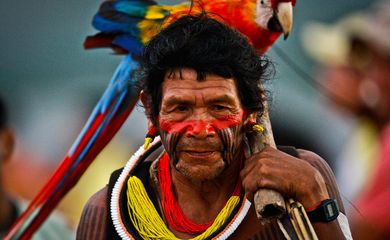In Brazil, indigenous in big cities face poverty and prejudice


Native Brazilians from the Maracanã indigenous village in Rio de Janeiro complained they have been neglected.

Living in urban centers without concealing one's lineage and one's own references is still a source of struggle for over 315 thousand indigenous people, according to figures from the latest census conducted by the Brazilian Geography and Statistics Institute (IBGE). The amount represents 49% of all of the country's indigenous population—a population celebrated on April 19, Brazil's Indian Day.
“Prejudice and discrimination are still strong. The indigenous living in big cities are the ones who really face such situations constantly, in their everyday lives,” says Eliandro Pedro de Sousa, of the Wapixana nation, head of the Organization of City Indians, in Boa Vista, northern Roraima state.
Of all cities throughout Brazil, São Paulo has the biggest indigenous population, with approximately 12 thousand inhabitants, followed by São Gabriel da Cachoeira, in Amazonas, with slightly more than 11 thousand, and Salvador, Bahia, with more than 7.5 thousand.
Anthropologist Lúcia Helena Rangel, of the Catholic University of São Paulo, notes that indigenous have been present in major cities ever since colonization times, but in past decades, the city was a forbidden space.
“They would move to the cities and not tell they were indigenous. They'd hide their background and also their cultural references,” she said. The fear of discrimination and retaliation on the part of the former Indian Protection Service kept them from presenting themselves as such.
In the 50s, when industrial development was conspicuous, migration to the cities grew stronger. Those who lived in the country were still in search of employment in the factories, and it was no different with the indigenous, the professor claims.
Even Brazil's National Indian Foundation (FUNAI), which aims to promote the rights of the Brazilian indigenous, faces prejudice and is aware of the predicament the indigenous living in the cities are forced to tackle, says FUNAI local coordinator for Roraima Riley Mendes.

About 4,000 indigenous people met at the Indigenous People's Week in São Félix do Xingu, Pará state, and stood up for their rights. The closing of the event was on the day Brazil celebrates its Indigenous People's Day (April 19).
The Amazon
The Amazon Rainforest has long stopped being home to thousands of indigenous. Scarce food, deforestation, and the advancement of cities into previously forested regions are some of the factors that drove members of traditional communities towards urban areas.
In Manaus, capital city of Amazonas state, they are everywhere to be found. The State Indian Foundation estimates that 15 to 20 thousand indigenous from of a number of ethnic groups live in urban areas across the state. “I believe that 90% of districts in Manaus have indigenous people living in them,” said State Indian Foundation head Raimundo Atroari.
Despite the search for better living conditions in the city, most indigenous live in misery, and a have difficulties finding a job. Their main source of income is arts and crafts. “Communities are usually located in risk areas. It's never a good place,” said indigenous chief Moisés Sateré, the leader of a community in the Paz district, western Manaus, home to 14 families.
Health Care
Sateré also complains about the difficult access to public health care services. “Sometimes we don't get service because professionals are often unaware of our reality and treat us with prejudice. When they notice we belong to some people, they start playing with us, saying we should go to the village to be served, or look for CASAI [Indigenous Health House]. They keep pushing us around,” he said.
According to Ronaldo Barros, of the Maraguá nation, chairman of the District Council for Indigenous Health Care of Manaus (CONDISI), public health care policies are directed at the indigenous living in villages. Those who live in the city face the same problems as the rest of the population. “They compete for the same beds and service the same way non-indigenous do in urban areas.”

Indigenous People's Week in São Félix do Xingu, Pará state
Resistance
Father Robert Marie de Zalicourt, of the Indigenous Missionary Council of Amazonas, believes that, in order to preserve their own references in the city, the indigenous have to unite. “Indigenous families can be found in every district in Manaus, but they're not recognized, so they tend to lose their own culture. They can preserve their particular traits when they're united and organized.”
Translated by Fabrício Ferreira
Fonte: In Brazil, indigenous in big cities face poverty and prejudice



